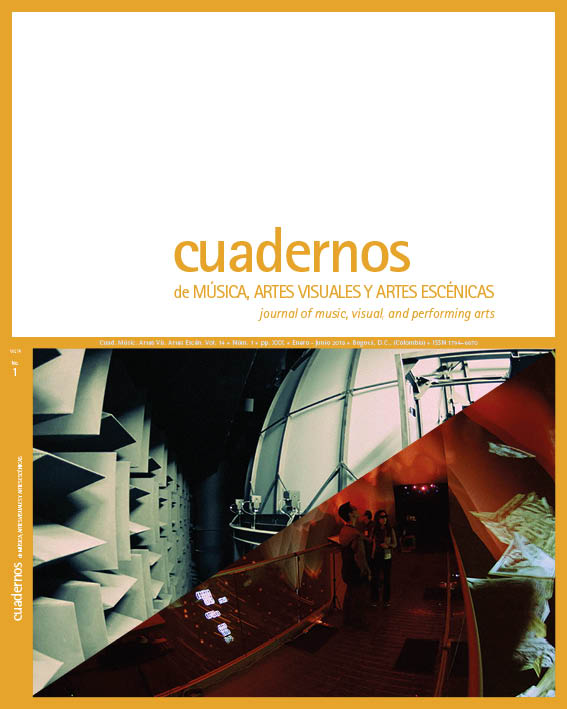Resumen
Varios profesores me aconsejaron llenar papel de pentagrama con lápiz quizá porque la razón a veces juega con la realidad y lo que se escribe a veces no suena como se quiere. Pero más a fondo, esta simpleza sobrepasa lo de ser tan solo un proceso de corrección o edición a representar la expresión de una idea. Pero las ideas no se materializan si no se confrontan con algún tipo de prejuicio o valoración. De acuerdo con un razonamiento, producto de la validación, se deja o se cambia la nota. Igual con una sucesión de notas y muy seguramente con frases y pedazos de una obra. Razón que hace pensar sobre un proceso de experimentación y laboratorio con el objeto de llegar a una propuesta. Los años han pasado, y aunque cada proyecto lo inicio con papel y lápiz, el grueso de esta labor ahora tiene más que ver con editores de texto en computador, por no hablar de abstracciones, modelos y ecuaciones, en el momento de combinar elementos en procesos de construcción de nuevos trabajos. A continuación, un recuento sobre trechos e influencias que han aportado a un lenguaje en las nuevas músicas, pero de utilidad en aproximaciones a lo acústico y sonoro. (...)
Battisti, E. 2018. “The Experimental Music Studio at UIUC, 1958-68: Environment, People, Activities”.Consultado: 6 de septiembre de 2018. http://cmp.music.illinois.edu/ems/history/The_Experimental_Music_Studio_at_UIUC_1958-68.pdf.
Burbano, Andrés, ed. Siegfried Zielinski: genealogías, visión, escucha y comunicación. Bogotá: Universidadde los Andes, 2006.
Chadabe, Joel. 1984. “Interactive Composing: An Overview”. Computer Music Journal 8 (1): 22-27.
Eco, Umberto. 1989. The Open Work. Traducido por Anna Cancogni. Cambridge: Harvard University Press.
Fetterman, William. 1996. John Cage’s Theatre Pieces. Londres: Routledge.
Harley, James. 2002. “The Electroacoustic Music of Iannis Xenakis”. Computer Music Journal 26 (1): 33-57.
Holtzman, Steven R. 1995. Digital Mantras: The Languages of Abstract and Virtual Worlds. Cambridge:The MIT Press.
Levitin, Daniel J. 2006. This Is Your Brain on Music: The Science of a Human Obsession. Londres: Penguin.
McLuhan, M. and Lapham, L. (1994). Understanding Media: The Extensions of Man. The MIT Press.
Mondloch, Katie. 2004. “A Symphony of Sensations in the Spectator: Le Corbusier’s Poème électronique and the Historicization of New Media Arts”. Leonardo 37 (11): 57-62.
[Schafer, 1993] Schafer, R. M. (1993). The Soundscape. Destiny Books.
Tsougras, Costas. 2005. Analysis of iannis xennakis’ “pour la paix” for a cappella mixed choir. En Definitive Proceedings of the “International Symposium Iannis Xenakis”, editado por Makis Solomos, Anastasia Georgaki, Giorgos Zervos. Atenas: International Symposium Iannis Xenakis.
University of Illinois Urbana-Champaign. 2018a. “About Salvatore Martirano”. Consultado: 28 de mayo de 2018. https://music.illinois.edu/about-salvatore-martirano.
— 2018b. “Experimental Music Studios”. Consultado: 14 de junio de 2018. https://music.illinois.edu/experimental-music-studios.
Wikipedia. 2017. Posthuman. https://en.wikipedia.org/wiki/Posthuman. Consultado: 12 de noviembre de 2018.
Esta revista científica se encuentra registrada bajo la licencia Creative Commons Reconocimiento 4.0 Internacional. Por lo tanto, esta obra se puede reproducir, distribuir y comunicar públicamente en formato digital, siempre que se reconozca el nombre de los autores y a la Pontificia Universidad Javeriana. Se permite citar, adaptar, transformar, autoarchivar, republicar y crear a partir del material, para cualquier finalidad, siempre que se reconozca adecuadamente la autoría, se proporcione un enlace a la obra original y se indique si se han realizado cambios. La Pontificia Universidad Javeriana no retiene los derechos sobre las obras publicadas y los contenidos son responsabilidad exclusiva de los autores, quienes conservan sus derechos morales, intelectuales, de privacidad y publicidad.
El aval sobre la intervención de la obra (revisión, corrección de estilo, traducción, diagramación) y su posterior divulgación se otorga mediante una licencia de uso y no a través de una cesión de derechos, lo que representa que la revista y la Pontificia Universidad Javeriana se eximen de cualquier responsabilidad que se pueda derivar de una mala práctica ética por parte de los autores. Como consecuencia de la protección brindada por la licencia de uso, la revista puede publicar retractaciones o corregir la información ya publicada. La publicación de contenidos en esta revista no representa regalías para los contribuyentes.


